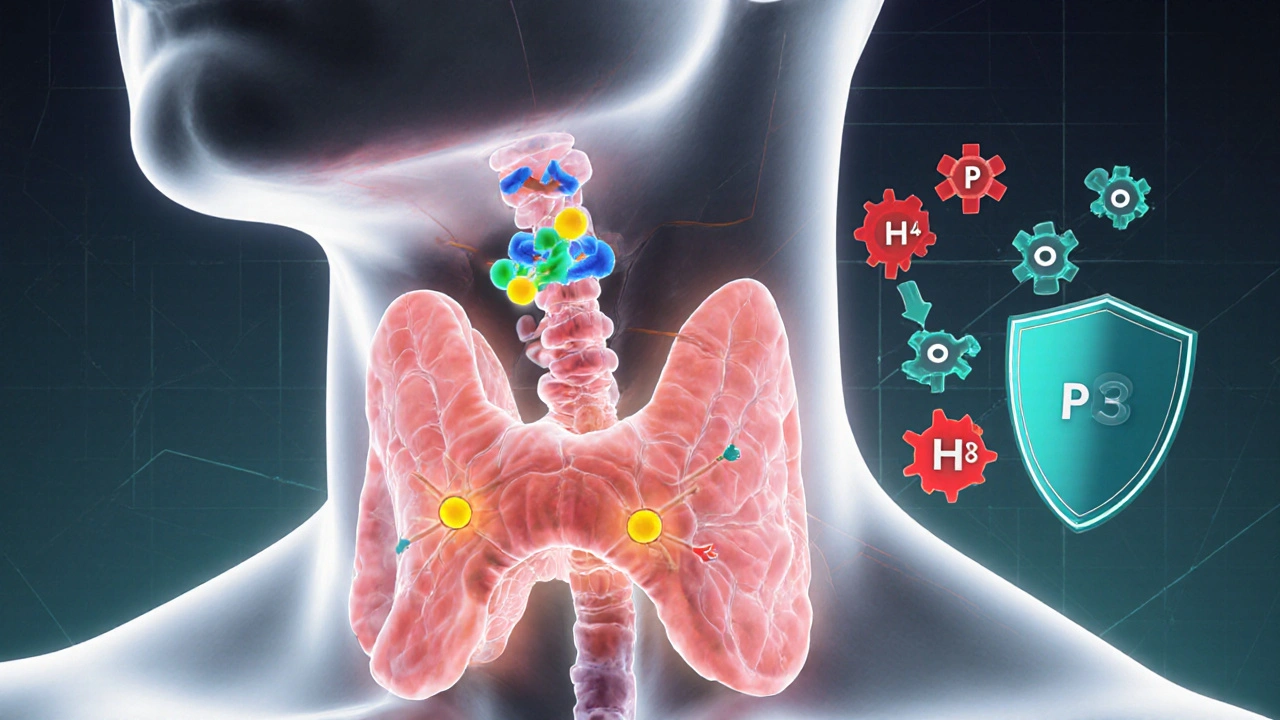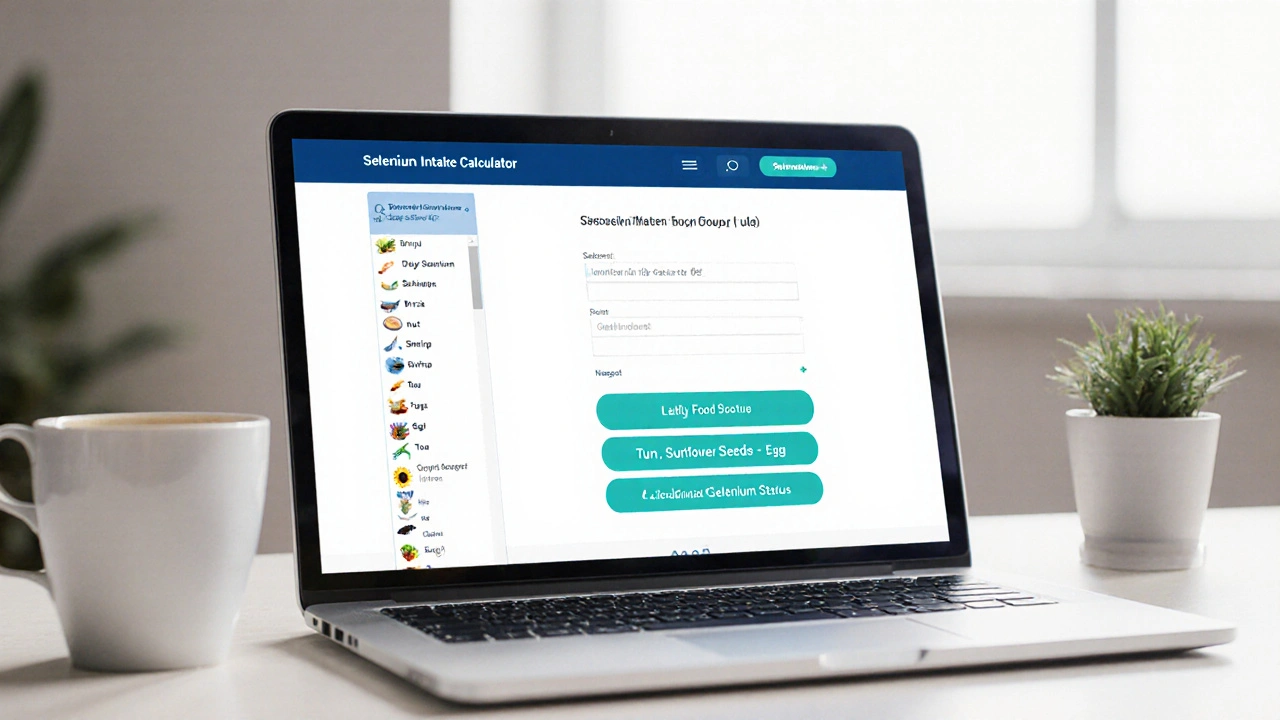Selenium Intake Calculator
Your Selenium Status
About Selenium for Thyroid Health
Selenium is crucial for thyroid hormone metabolism. It helps convert T4 to the active T3 hormone and acts as an antioxidant protecting the thyroid gland.
Recommended Daily Allowance: 55 µg for adults
Upper Limit: 400 µg per day to avoid toxicity
Best Sources: Brazil nuts, fish, eggs, and shellfish
Key Takeaways
- Selenium is essential for making and activating thyroid hormones.
- People with Hashimoto's thyroiditis often have low selenium levels.
- Brazil nuts, fish, and eggs are the best natural sources.
- Supplementation of 100‑200µg/day can lower thyroid‑peroxidase antibodies in many cases.
- High doses can be toxic; stay within recommended limits.
When you hear the word Selenium thyroid deficiency, you might wonder why a trace mineral matters for a gland that sits deep in your neck. The short answer: without enough selenium, the thyroid can’t protect itself from oxidative damage, and hormone production stalls. This article walks you through what selenium does, who benefits most, and how to use it safely.
What Is Selenium?
Selenium is a trace mineral that functions primarily as a component of selenoproteins, which act as antioxidants and regulators of thyroid hormone metabolism. Your body needs just a few micrograms each day, but those tiny amounts have outsized effects, especially in the thyroid.
How the Thyroid Works and Why Deficiency Happens
The thyroid gland is a butterfly‑shaped organ in the neck that produces the hormones thyroxine (T4) and triiodothyronine (T3). These hormones control metabolism, temperature, and heart rate. To make them, the gland first captures iodine, another essential trace element.
Thyroid hormones T4 is the inactive form, while T3 is the active form that drives metabolic processes. Conversion of T4 to T3 requires enzymes that depend on selenium.
When iodine intake is low or when auto‑immune attacks (like Hashimoto's thyroiditis is an autoimmune condition where the body produces antibodies against its own thyroid tissue. ) damage the gland, selenium becomes a critical defender.

Selenium’s Role in Hormone Synthesis
Two selenoproteins, iodothyronine deiodinases, convert T4 into the active T3. Without enough selenium, these enzymes work sluggishly, leaving you with high T4 but low T3-exactly the pattern seen in many deficiency cases.
Another key player is glutathione peroxidase an antioxidant enzyme that uses selenium to neutralize hydrogen peroxide and lipid‑peroxide radicals. The thyroid produces a lot of hydrogen peroxide during hormone synthesis, so this enzyme protects the tissue from oxidative injury.
When selenium levels dip, oxidative stress rises, leading to inflammation and, over time, to the production of thyroid‑peroxidase antibodies (TPOAb). Lowering that antibody load is a primary target for many clinicians.
What the Research Says
Several randomized trials in the past decade have measured the impact of selenium supplementation on thyroid outcomes. A 2013 Swiss study gave 200µg of selenomethionine daily to 132 patients with Hashimoto's. After six months, TPOAb levels dropped by an average of 40%, and 30% of participants reported improved energy. In a 2021 meta‑analysis of 9 trials, the pooled reduction in TPOAb was 35% for doses between 100‑200µg/day, with no significant change in TSH (thyroid‑stimulating hormone) for most patients. These numbers suggest selenium works best when the immune system is the main culprit, rather than simple iodine deficiency.
Practical Guidance: Food Sources and Supplementation
Getting selenium from food is usually safe and bioavailable. One Brazil nut contains 68‑91µg, covering the recommended daily allowance (RDA) of 55µg for adults. Other good sources include:
- Yellowfin tuna - 50µg per 3‑oz serving
- Shrimp - 35µg per 3‑oz serving
- Sunflower seeds - 14µg per ounce
- Eggs - 15µg per large egg
If you’re not a fan of nuts or seafood, a daily supplement of 100‑200µg of selenomethionine is the most studied form. Take it with food to improve absorption.
It’s wise to test your serum selenium and TPOAb before starting, especially if you’re already on levothyroxine a synthetic thyroid hormone used to treat hypothyroidism. Selenium can slightly increase the conversion of T4 to T3, meaning your dose of levothyroxine might need tweaking after a few weeks.
Comparison: Selenium vs. Iodine for Thyroid Health
| Aspect | Selenium | Iodine |
|---|---|---|
| Primary function | Co‑factor for deiodinases & antioxidant enzymes | Building block of T4 and T3 hormones |
| Deficiency symptom | Elevated TPOAb, reduced T3 conversion | Goiter, low T4/T3 production |
| Typical RDA | 55µg (adult) | 150µg (adult) |
| Major food sources | Brazil nuts, tuna, shrimp | Seaweed, dairy, iodized salt |
| Toxicity threshold | >400µg/day (risk of selenosis) | >1mg/day (risk of thyroid dysfunction) |

Who Benefits Most from Selenium?
While everyone needs a baseline amount, certain groups see the biggest payoff:
- Patients with Hashimoto's thyroiditis - lowering antibodies can slow disease progression.
- Pregnant women with low selenium - adequate levels support fetal brain development and reduce miscarriage risk.
- Individuals on long‑term levothyroxine - selenium can improve conversion efficiency, sometimes allowing a modest dose reduction.
People with simple iodine deficiency, such as those living in inland regions with low seafood intake, should prioritize iodine first; selenium alone won’t fix a true lack of iodine.
Safety, Dosage, and Potential Side Effects
The tolerable upper intake level (UL) for adults is 400µg per day. Exceeding this can cause selenosis - symptoms include brittle nails, hair loss, and a garlic‑like breath. If you’re already eating Brazil nuts daily, you might already be near the UL, so a supplemental dose of 100µg is usually enough. Always discuss with your healthcare provider before adding selenium, especially if you have kidney disease, are on anticoagulants, or are pregnant.
Quick Checklist for Managing Thyroid Deficiency with Selenium
- Get baseline labs: serum selenium, TPOAb, TSH, free T4, free T3.
- If TPOAb > 100IU/mL, consider 100‑200µg/day of selenomethionine.
- Include 1‑2 Brazil nuts or a serving of fish a few times a week.
- Re‑check labs after 3‑6 months; adjust levothyroxine dose if T3 improves.
- Never exceed 400µg/day total from food + supplements.
Frequently Asked Questions
Can selenium replace levothyroxine?
No. Selenium supports hormone conversion and reduces inflammation, but it doesn’t provide the hormone itself. It’s an add‑on, not a substitute.
How long does it take to see benefits?
Most studies report measurable drops in TPOAb after 3‑6 months of consistent supplementation. Symptom improvement may be noticeable sooner, but lab changes take time.
Is selenium safe during pregnancy?
Yes, within the RDA (55µg) and up to 200µg from supplements, selenium is considered safe and may lower the risk of pre‑eclampsia and support fetal development.
What forms of selenium are best for the thyroid?
Selenomethionine and sodium selenite are the most studied. Selenomethionine has higher bioavailability and is often recommended for thyroid support.
Can I get enough selenium from diet alone?
Yes, if you regularly eat Brazil nuts, fish, or shellfish. One to two Brazil nuts per day usually meet the RDA.
Bottom line: Selenium isn’t a miracle cure, but for many dealing with thyroid auto‑immunity or poor hormone conversion, a modest boost can make a real difference. Pair it with adequate iodine, a balanced diet, and regular monitoring, and you’ll give your thyroid the support it deserves.


Gabe Crisp
October 5, 2025 AT 12:33Your trust in selenium is misplaced; it's a pharma ploy.
Paul Bedrule
October 11, 2025 AT 00:33From a semiotic perspective, selenium functions as a micronutrient catalyst within the endocrine ontology, effectuating the T4-to-T3 conversion cascade. The biochemistry is undergirded by selenoprotein P's redox buffering capacity, which modulates oxidative stress at the follicular interface. In clinical praxis, the dosage parameters intersect with the hormetic curve, delineating a therapeutic window between 55 µg and 200 µg. Moreover, epidemiological meta‑analyses reveal a statistically significant correlation (p < 0.05) between adequate selenium status and attenuated thyroid autoantibody titers. Consequently, the integrative supplementation schema warrants judicious implementation alongside iodine repletion.
yash Soni
October 16, 2025 AT 12:33Wow, look at that, some fancy jargon for a nut. It’s not rocket science – you eat a Brazil nut, you get selenium, you feel a bit better. If you’re so worried about "statistical significance", just stop overthinking and grab a handful.
Emily Jozefowicz
October 22, 2025 AT 00:33Ah, the classic "let’s sprinkle some science on your diet" routine – love it when people try to sound clever while basically saying “eat more nuts”. The sarcasm is palpable, but hey, at least it’s not a scary conspiracy theory, right?
Franklin Romanowski
October 27, 2025 AT 11:33I get where you’re coming from – the thyroid can be a tricky organ, and selenium does have a role in hormone conversion. If you’re experimenting with supplements, keep a journal of how you feel and talk to your clinician about lab work. Small, consistent changes often trump big, dramatic overhauls.
Brett Coombs
November 1, 2025 AT 23:33Listen, the whole “big pharma” angle is just a distraction – they’re not hiding selenium, they’re hiding the truth about how the government controls our diets. Grab a couple of nuts and stay woke.
John Hoffmann
November 7, 2025 AT 11:33While the content is generally accurate, note the misuse of the term "convert" – the biochemical pathway involves deiodination, not a simple conversion. Also, ensure the units (µg) remain consistent throughout; otherwise the reader could be misled.
Shane matthews
November 12, 2025 AT 23:33Interesting take. i think the article does a decent job but could use more citations especially when discussing optimal dosage ranges.
Rushikesh Mhetre
November 18, 2025 AT 11:33Great job breaking down the selenium calculator! 👍 Remember to pair selenium with adequate iodine for optimal thyroid support. Keep the enthusiasm going – your readers will thank you for the clear guidance.
Sharath Babu Srinivas
November 23, 2025 AT 23:33Nice article! 😊 Just a heads‑up: the line "seleniumIntake = 55 && seleniumIntake 100IU/mL" looks like a typo – probably should be "<= 100 IU/mL". Minor fix, but important for clarity.
Halid A.
November 29, 2025 AT 11:33Could you elaborate on the recommended frequency for re‑checking thyroid labs after initiating selenium supplementation? A formal outline would be helpful for clinicians.
Brandon Burt
December 4, 2025 AT 23:33Well, this article does a fairly decent job of summarizing the basics of selenium and thyroid health, but it could definitely benefit from a deeper dive into the potential interactions with levothyroxine therapy, the variations in bioavailability between selenomethionine and sodium selenite, as well as a more thorough discussion on the upper safety thresholds, especially for individuals who might be consuming multiple selenium‑rich foods alongside supplementation; otherwise, some readers might overlook the cumulative effect and inadvertently exceed the 400 µg daily limit, which could lead to selenosis symptoms such as gastrointestinal upset, hair loss, and in severe cases, neurological disturbances.
Gloria Reyes Najera
December 10, 2025 AT 11:33Yo wheres the real data? This sounds like some random blog post. They should at least mention the study from Sweden that proved selenium helps with autoimmunity. Also, stop misspelling "thyroid" like that.
Gauri Omar
December 15, 2025 AT 23:33Seriously? Another article about nuts and hormones? I guess if you’re into the drama of micronutrients, go ahead. But don’t expect miracles – the thyroid isn’t a magic trick, it’s a complex organ.
Willy garcia
December 21, 2025 AT 11:33Nice overview. If you’re considering selenium, start with a low dose and monitor your symptoms. It’s a sensible approach.